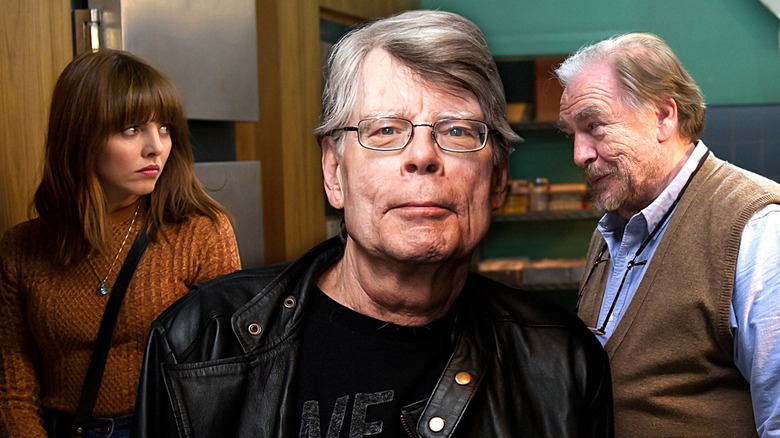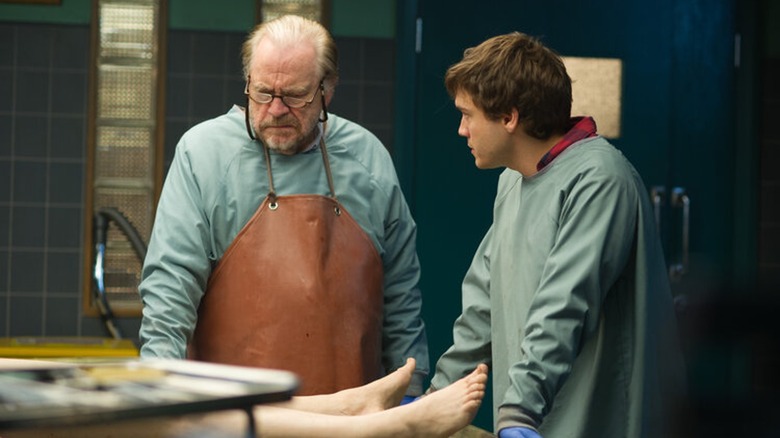The Horror Movie You Shouldn't Watch Alone, According To Stephen King
Stephen King often takes to Twitter (I'm never going to call it that other thing) to give us timely movie and series recommendations, highlight under-the-radar gems, or simply express the joy of reading a good book. As one of the world's greatest authors, King intimately understands the inner workings of the horror genre, including themes that work best to provoke the human imagination and induce anxiety with the help of a sustained suspension of disbelief. The writer's horror-related recommendations have always been top notch; a few years back, King praised a 2016 supernatural horror film on Twitter and advised us to not watch it alone:
"THE AUTOPSY OF JANE DOE: Visceral horror to rival ALIEN and early Cronenberg. Watch it, but not alone."
He's right. André Øvredal's "The Autopsy of Jane Doe," which we reviewed upon release, understands that the gnarliest kind of horror lies in the unraveling of a simple premise, where the most jarring aspect is not the jump scares or the gore, but the futility of going up against a cycle of trauma that can't be stopped. One of the things Øvredal's first English-language film does best is not fully lean into the sensationalism of it all, but opt for a taut, reined-in style instead, which helps sustain a sense of claustrophobic dread while the terrors ramp up. Let's dissect what makes "The Autopsy of Jane Doe" so scary, and why it deserves a more nuanced spotlight almost half a decade after its release.
The Autopsy of Jane Doe offers a chilling horror premise
When the corpse of the titular Jane Doe (played by Olwen Kelly) is found at the scene of a crime, coroners Austin (Emile Hirsch) and Tommy (the great Brian Cox, whose best movies we ranked here) are brought in for a last-minute autopsy to ascertain the cause of the victim's death. The father-son duo confine themselves inside a morgue in small-town Virginia and gradually peel back the layers of a horrific crime, where the clues present themselves in the form of a severed tongue, shattered wrist bones, and a missing molar. A sense of bafflement settles in as the body shows no signs of rigor mortis, making it impossible to discern the time of death, but this confusion morphs into pure terror when the corpse displays signs of life that become impossible to be disregarded as a scientific phenomenon.
If the external signs of trauma and subtle movement were not disturbing enough, the state of the internal organs denotes something deeply sinister. As the autopsy progresses, Tommy and Austin's immediate reality changes, actively putting them and their loved ones in danger as they try to solve the puzzle pieces that Jane Doe's corpse presents in the form of increasingly concerning clues.
The disenfranchisement that comes with death is an extension of Jane Doe's existence when she was alive: Even now, her trauma is being poked and prodded by men who solely view her as evidence, who approach the battered aspects of her corpse with clinical detachment. Of course, both Tommy and Austin are coroners — professionals who need to maintain an objective stance that relies upon that clinical level of discernment — but their initial reluctance to entertain supernatural phenomena or acknowledge the ritualistic undertones of her trauma emerge as obstacles to the detachment that's demanded of them. The climax is pure action, which feels somewhat antithetical to the mood established leading up to that moment, but it becomes clear that no one can stand between Jane Doe and her wrath, even if they harbor benign intentions. In the end, only revenge and tragedy prevail. No wonder Stephen King found it worthy to recommend.

